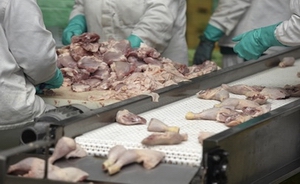For two week s this past March, an audit team from USDA’s Food Safety and Inspection Service (FSIS) was all over the People’s Republic of China’s poultry-processing system.
s this past March, an audit team from USDA’s Food Safety and Inspection Service (FSIS) was all over the People’s Republic of China’s poultry-processing system.
Their task was to determine if China’s processing “remains equivalent to that of the United States, with the ability to produce products that are safe, wholesome, unadulterated, and properly labeled.”
The conclusion, based on corrective actions the Chinese took in response to the last audit in 2010, was that China’s General Administration for Quality and Safety Inspection and Quarantine (AQSIQ) passed the test — its regulation of poultry production is up to USDA standards.
This means that four poultry processors in China will be able to ship cooked poultry products to the U.S. The chickens will have to originate here, but it also might be the first step toward the day when birds raised and slaughtered in China could fill dinner plates in the U.S.
Like its other foreign audits, the FSIS investigation of China’s poultry-processing plants was exhaustive. It included government oversight, statutory authority and regulations, sanitation practices, hazard analysis and critical control point planning, chemical residue programs and microbiological testings.
In each area, FSIS requires the foreign government reach a standard that is at least equivalent to USDA standards. In China, the two-week audit began and ended in Beijing, but focused on four poultry-processing establishments: Qingdao 9-Alliance Group, Ltd.; Zhucheng Waimao Co., Ltd., Weifang Legang Food Co., Ltd, and Zhong AO Holdings Co., Ltd.
All four establishments were investigated based on provisions of both U.S. and Chinese food-safety law. China first requested U.S. inspection in 2004, and while it was added to the U.S. list of countries for which export of processed poultry was allowed in 2006, restrictions were imposed because China was not free of highly pathogenic Avian flu and exotic Newcastle Disease.
Since 2010, however, China has taken corrective actions and sought a re-examination by the U.S. FSIS then found the inspection system in the People’s Republic “meets the requirement for this equivalence component.”
 s this past March, an audit team from USDA’s Food Safety and Inspection Service (FSIS) was all over the People’s Republic of China’s poultry-processing system.
s this past March, an audit team from USDA’s Food Safety and Inspection Service (FSIS) was all over the People’s Republic of China’s poultry-processing system.Their task was to determine if China’s processing “remains equivalent to that of the United States, with the ability to produce products that are safe, wholesome, unadulterated, and properly labeled.”
The conclusion, based on corrective actions the Chinese took in response to the last audit in 2010, was that China’s General Administration for Quality and Safety Inspection and Quarantine (AQSIQ) passed the test — its regulation of poultry production is up to USDA standards.
This means that four poultry processors in China will be able to ship cooked poultry products to the U.S. The chickens will have to originate here, but it also might be the first step toward the day when birds raised and slaughtered in China could fill dinner plates in the U.S.
Like its other foreign audits, the FSIS investigation of China’s poultry-processing plants was exhaustive. It included government oversight, statutory authority and regulations, sanitation practices, hazard analysis and critical control point planning, chemical residue programs and microbiological testings.
In each area, FSIS requires the foreign government reach a standard that is at least equivalent to USDA standards. In China, the two-week audit began and ended in Beijing, but focused on four poultry-processing establishments: Qingdao 9-Alliance Group, Ltd.; Zhucheng Waimao Co., Ltd., Weifang Legang Food Co., Ltd, and Zhong AO Holdings Co., Ltd.
All four establishments were investigated based on provisions of both U.S. and Chinese food-safety law. China first requested U.S. inspection in 2004, and while it was added to the U.S. list of countries for which export of processed poultry was allowed in 2006, restrictions were imposed because China was not free of highly pathogenic Avian flu and exotic Newcastle Disease.
Since 2010, however, China has taken corrective actions and sought a re-examination by the U.S. FSIS then found the inspection system in the People’s Republic “meets the requirement for this equivalence component.”





